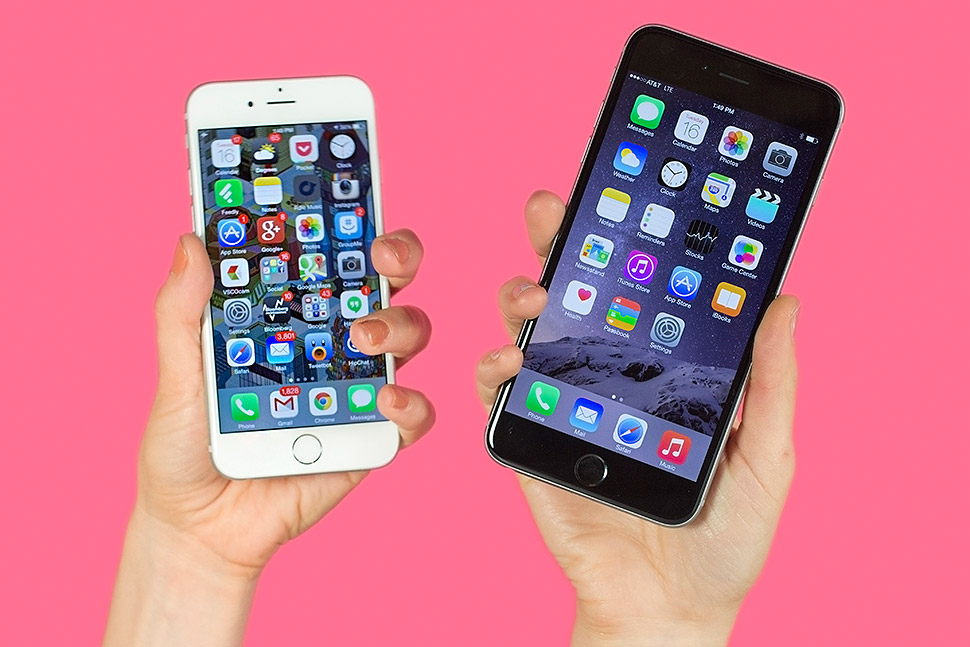I don’t know if you’ve heard, but there’s a new iPhone. Two, actually. The iPhone 6 and the iPhone 6 Plus.
This isn’t just a regular phone release from the cats in Cupertino. With the new devices, Apple (AAPL) enters a market in which it has literally been unable to compete: the market for big, big devices, currently dominated by Korean giant (and Apple nemesis) Samsung Electronics (005930: KS) and its Galaxy S line of Android phones. According to court documents revealed earlier this year, Apple executives lamented the company’s lack of a larger phone in a marketing slideshow. “Consumers want what we don’t have,” read one slide as it showed the growth of the jumbo-phone market.
Well, so much for that problem.
The new iPhones are bigger than any previous version—their displays measure 4.7 inches for the 6 and 5.5 inches for the 6 Plus. They’re also awesome. They are beautifully engineered machines, more useful than ever. These aren’t just the best iPhones ever made—they might be the best phones ever made. Period. The only question you really have to answer is: Which one?

First, some basics. The iPhone 6 and 6 Plus are significantly redesigned compared with last year’s iPhone 5S and 5C. Both devices utilize an ultrathin unibody aluminum enclosure, one that bears a startling resemblance to the original iPhone from 2007, and the devices can be bought in “space” gray, silver, or gold. The iPhone 6 is just 6.9mm in thickness (in comparison the 5S seems flabby with its 7.6mm profile), while the 6 Plus is only 7.1mm. Both feel svelte and lean in your hand—solid, with good weight, but incredibly skinny. Though I must say, while the iPhone 5S stood out in a crowd of Android smartphones with its chamfered edges and Leica-esque controls, you might not know the iPhone 6 next to the latest Galaxy S5 or the HTC One. And while the design is still impressive, some details feel a bit off. The bold antenna lines that run around the back of the devices and the protruding camera lens make the phones seem slightly less disciplined compared with the company’s previous work.
As you would expect, Apple has made all of the appropriate improvements to the guts of the phones as well: faster processors, better cameras, and of course higher-resolution screens. Apple will tell you that these are the fastest mobile devices it’s ever made, and it wouldn’t be lying. These phones scream.
New features such as Wi-Fi calling, voice over LTE (VoLTE), and a new near-field communications (NFC) wireless chip are present, though not everyone will be able to take advantage of those features right off the bat. Mind you, Android devices have been able to take advantage of some of the features for a while (Wi-Fi calling on T-Mobile, for instance), but it’s nice to see Apple making an effort.
Battery life has been improved in the two models, but I’m sorry to report that even a big iPhone 6 doesn’t deliver an all-day charge if you’re a heavy user or in an area without strong wireless signals. It is better than the 5S, and the iPhone 6 Plus yields better results thanks to its size. This is a notable whiff given the fact that so many iPhone users have complained about the current model’s battery, and I think most consumers would have sacrificed some thinness for a more robust daily life span. I experienced several days during the review period where I barely made it to the charger before the phone lost power.
On the plus side, the iPhone camera continues to be in a class by itself. The improvements Apple has made prove that the iPhone isn’t just a fantastic smartphone with a camera; it’s a fantastic camera, period. The 8-megapixel shooter might not have the super-high resolution the latest Samsung or Nokia (NOK) phones tout, but it was able to take consistently beautiful photos in almost any setting, light or dark. Apple has improved the software side of picture-taking as well. In the Photos app, there are more powerful editing features, and you now have the ability to search your images. I’m encouraged by Apple’s new handling of photos (as well as its use of iCloud as an off-device storage solution), but Google (GOOG) still does a superior job with Google+, which stores all of your pics and video in the cloud automatically and offers search of not just the people and places in the content, but objects themselves.
And while I know it’s fantastically uncool to use a phone for its phone functions, it should be noted that the iPhone 6 and 6 Plus offer remarkable sound quality, both through the earpiece and out of the speaker at the bottom of the devices.
Is this really the best solution for dealing with a big screen?
Weirdly, even though these phones are much bigger than any previous iPhone, using them wasn’t a very new experience. To counteract the issue of having a screen in your hand that is far too large for single-handed use, Apple has created a new feature called Reachability. You simply double-press (that’s a light tap) on your home button and it brings the top of the screen down to reach your thumb. It sounds like a clever trick, and in practice it works, though it looks and feels a little clunky—a very version 1.0 experience. Is this really the best solution for dealing with a big screen?
(Bloomberg Businessweek)



